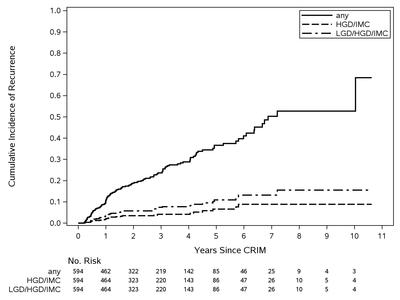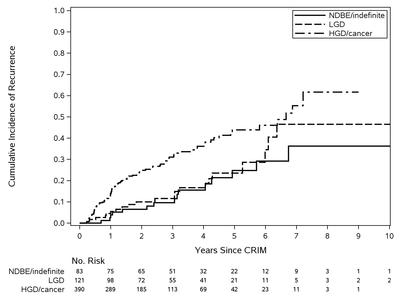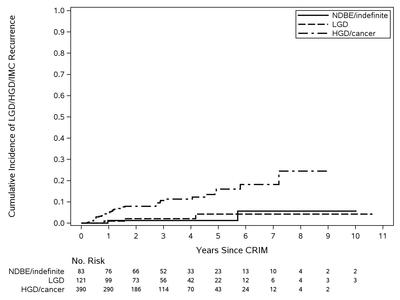Sami, S;
Ravindran, A;
Kahn, A;
Snyder, D;
Santiago, J;
Ortiz-Fernandez-Sordo, J;
Tan, WK;
... Iyer, PG; + view all
(2019)
Timeline and location of recurrence following successful ablation in Barrett's oesophagus: an international multicentre study.
Gut
, 68
(8)
pp. 1379-1385.
10.1136/gutjnl-2018-317513.

Preview |
Text (Article)
Sami_GUT recurrence Manuscript R1 clean v2.pdf - Accepted Version Download (510kB) | Preview |
Preview |
Image (Figure 1)
Figure 1 patient flowchart.tif - Accepted Version Download (14MB) | Preview |
![[thumbnail of Figure 2]](https://discovery.ucl.ac.uk/10072691/8.hassmallThumbnailVersion/Figure%202.jpeg)  Preview |
Image (Figure 2)
Figure 2.jpeg - Accepted Version Download (148kB) | Preview |
![[thumbnail of Figure 3]](https://discovery.ucl.ac.uk/10072691/13.hassmallThumbnailVersion/Figure%203.jpeg)  Preview |
Image (Figure 3)
Figure 3.jpeg - Accepted Version Download (146kB) | Preview |
![[thumbnail of Figure 4]](https://discovery.ucl.ac.uk/10072691/19.hassmallThumbnailVersion/Figure%204.jpeg)  Preview |
Image (Figure 4)
Figure 4.jpeg - Accepted Version Download (145kB) | Preview |
Preview |
Image (Figure 5)
Figure 5.tif - Accepted Version Download (208kB) | Preview |
Abstract
OBJECTIVE: Surveillance interval protocols after complete remission of intestinal metaplasia (CRIM) post radiofrequency ablation (RFA) in Barrett’s oesophagus (BE) are currently empiric and not based on substantial evidence. We aimed to assess the timeline, location and patterns of recurrence following CRIM to inform these guidelines. DESIGN: Data on patients undergoing RFA for BE were obtained from prospectively maintained databases of five (three USA and two UK) tertiary referral centres. RFA was performed until CRIM was confirmed on two consecutive endoscopies. RESULTS: 594 patients achieved CRIM as of 1 May 2017. 151 subjects developed recurrent BE over a median (IQR) follow-up of 2.8 (1.4–4.4) years. There was 19% cumulative recurrence risk of any BE within 2 years and an additional 49% risk over the next 8.6 years. There was no evidence of a clinically meaningful change in the recurrence hazard rate of any BE, dysplastic BE or high-grade dysplasia/cancer over the duration of follow-up, with an estimated 2% (95% CI −7% to 12%) change in recurrence rate of any BE in a doubling of follow-up time. 74% of BE recurrences developed at the gastro-oesophageal junction (GOJ) (24.1% were dysplastic) and 26% in the tubular oesophagus. The yield of random biopsies from the tubular oesophagus, in the absence of visible lesions, was 1% (BE) and 0.2% (dysplasia). CONCLUSIONS: BE recurrence risk following CRIM remained constant over time, suggesting that lengthening of follow-up intervals, at least in the first 5 years after CRIM, may not be advisable. Sampling the GOJ is critical to detecting recurrence. The requirement for random biopsies of the neosquamous epithelium in the absence of visible lesions may need to be re-evaluated.
| Type: | Article |
|---|---|
| Title: | Timeline and location of recurrence following successful ablation in Barrett's oesophagus: an international multicentre study |
| Open access status: | An open access version is available from UCL Discovery |
| DOI: | 10.1136/gutjnl-2018-317513 |
| Publisher version: | http://doi.org/10.1136/gutjnl-2018-317513 |
| Language: | English |
| Additional information: | This version is the author accepted manuscript. For information on re-use, please refer to the publisher’s terms and conditions. |
| UCL classification: | UCL UCL > Provost and Vice Provost Offices > School of Life and Medical Sciences UCL > Provost and Vice Provost Offices > School of Life and Medical Sciences > Faculty of Medical Sciences UCL > Provost and Vice Provost Offices > School of Life and Medical Sciences > Faculty of Medical Sciences > Div of Surgery and Interventional Sci |
| URI: | https://discovery.ucl.ac.uk/id/eprint/10072691 |
Archive Staff Only
 |
View Item |


